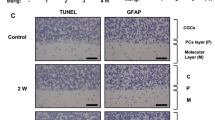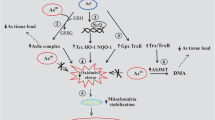Abstract
The thioredoxin (Trx) system, involving redox active Trxs and thioredoxin reductases (TrxRs), sustain a number of important Trx-dependent pathways. These redox active proteins support several processes crucial for cell function, cell proliferation, antioxidant defense, and redox-regulated signaling cascades. Methylmercury (MeHg) is an important environmental toxicant that has a high affinity for thiol groups and can cause oxidative stress. The Trx system is the major system responsible for maintaining the redox state of cells and this function involves thiol reduction mediated by selenol groups in TrxRs. MeHg has a great affinity to thiols and selenols, thus the potential toxic effects of MeHg on TrxR inhibition were determined in the current study. A single administration of MeHg (1, 5, and 10 mg/Kg) caused a marked inhibition of kidney TrxR activity, while significant inhibition was observed in the liver after exposure to 5 and 10 mg/Kg of MeHg. TrxR activity was determined 24 h after MeHg. In the brain, MeHg did not inhibit TrxR activity. In vitro exposure to MeHg indicated that MeHg inhibits cerebral (IC50, 0.158 μM), hepatic (IC50, 0.071 μM), and renal TrxR activity (IC50, 0.078 μM). The results presented herein demonstrated for the first time that renal and hepatic TrxRs can serve as an in vivo target for MeHg. This study suggests that MeHg can bind to selenocysteine residues present in the catalytic site of TrxR, in turn causing enzyme inhibition that can compromise the redox state of cells.






Similar content being viewed by others
References
Arner ESJ, Holmgren A (2000) Physiological functions of thioredoxin and thioredoxin reductase. Eur J Biochem 267:6102–6109. doi:10.1046/j.1432-1327.2000.01701
Aschner M, Syversen T, Souza DO, Rocha JBT, Farina M (2007) Involvement of glutamate and reactive oxygen species in methylmercury neurotoxicity. Braz J Med Biol Res 40:285–291. doi:10.1590/S0100-879X2007000300001
Ballatori N (2002) Transport of toxic metals by molecular mimicry. Environ Health Perspect 110:689–694
Behne D, Pfeifer H, Rothlein D, Kyriakopoulos A (2000) Cellular and subcellular distribution of selenium and selenium-containing proteins in the rat. In: Roussel AM, Favier AE, Anderson RA (eds) Trace elements in man and animals. Kluwer Academic/Plenum Publishers, New York, pp 29–34
Carvalho CM, Chew EH, Hashemy SI, Lu J, Holmgren A (2008) Inhibition of the human thioredoxin system. A molecular mechanism of mercury toxicity. J Biol Chem 283:11913–11923. doi:10.1074/jbc.M710133200
Clarkson TW, Magos L (2006) The toxicology of mercury and its chemical compounds. Crit Rev Toxicol 36:609–662. doi:10.1080/10408440600845619
Clarkson TW, Magos L, Myers GJ (2003) The toxicology of mercury-current exposures and clinical manifestations. New Engl J Med 349:1731–1737
da Conceição Nascimento M, Nascimento JLMD, de Lima Silveira LC, da Rocha JBT, Aschner M (2009) Mercury and selenium—a review on aspects related to the health of human populations in the Amazon. Environ Bioindic 4:222–245
de Freitas AS, Funck VF, Rotta MS, Bohrer D, Mörschbächer V, Puntel RL, Nogueira CW, Farina M, Aschner M, Rocha JBT (2009) Diphenyl diselenide, a simple organoselenium compound, decreases methylmercury-induced cerebral, hepatic and renal oxidative stress and mercury deposition in adult mice. Brain Res Bull 79:77–84. doi:10.1016/j.brainresbull.2008.11.001
Du Y, Wu Y, Cao X, Cui W, Zhang H, Tian W, Ji M, Holmgren A, Zhong L (2009) Inhibition of mammalian thioredoxin reductase by black tea and its constituents: implications for anticancer actions. Biochimie 91:434–444. doi:10.1016/j.biochi.2008.11.005
Fang J, Holmgren A (2006) Inhibition of thioredoxin and thioredoxin reductase by 4-hydroxy-2-nonenal in vitro and in vivo. J Am Chem Soc 128:1879–1885. doi:10.1021/ja057358l
Farina M, Campos F, Vendrell I, Berenguer J, Barzi M, Pons S, Suñol C (2009a) Probucol increases glutathione peroxidase-1 activity and displays long-lasting protection against methylmercury toxicity in cerebellar granule cells. Toxicol Sci 112:416–426. doi:10.1093/toxsci/kfp219
Farina M, Rocha JBT, Aschner M (2009b) Oxidative stress and methylmercury-induced neurotoxicity. In: Slikker W, Wang C (eds) Developmental neurotoxicology research: principles, models, techniques, strategies and mechanisms. John Wiley & Sons, Indianapolis
Fonfria E, Vilaro MT, Babot Z, Rodriguez-Farre E, Sunol C (2005) Mercury compounds disrupt neuronal glutamate transport in cultured mouse cerebellar granule cells. J Neurosci Res 79:545–553. doi:10.1002/jnr.20375
Holmgren A (1985) Thioredoxin. Annu Rev Biochem 54:237–271. doi:10.1146/annurev.bi.54.070185.001321
Holmgren A, Bjornstedt M (1995) Thioredoxin and thioredoxin reductase. Meth Enzymol 252:199–208
Horai S, Furukawa T, Ando T, Akiba S, Takeda Y, Yamada K, Kuno K, Abe S, Watanabe I (2008) Subcellular distribution and potential detoxification mechanisms of mercury in the liver of the Javan mongoose (Herpestes javanicus) in Amamioshima Island. Japan Environ Toxicol Chem 27:1354–1360
Hultberg B, Andersson A, Isaksson A (2001) Interaction of metals and thiols in cell damage and glutathione distribution: potentiation of mercury toxicity by dithiothreitol. Toxicology 156:93–100. doi:10.1016/S0300-483X(00)00331-0
Li D, Wub K, Howie AF, Beckett GF, Wang W, Bao Y (2008) Synergy between broccoli sprout extract and selenium in the upregulation of thioredoxin reductase in human hepatocytes. Food Chem 110:193–198. doi:10.1016/j.foodchem.2008.01.032
Lillig CH, Holmgren A (2007) Thioredoxin and related molecules: from biology to health and disease. Antioxid Redox Signal 9:25–47. doi:10.1089/ars.2007.9.25
Lowry OH, Rosebrough NJ, Farr AL, Randall RJ (1951) Proteinmeasurement with the Folin phenol reagent. J Biol Chem 193:265–275
Mahboob M, Shireen KF, Atkinson A, Khan AT (2001) Lipid peroxidation and antioxidant enzyme activity in different organs of mice exposed to low level of mercury. J Environ Sci Health B 36:687–697
Ralston NVC, Ralston CR, Blackwell IlI JL, Raymond LJ (2008) Dietary and tissue selenium in relation to methylmercury toxicity. NeuroToxicology 29:802–811. doi:10.1016/j.neuro.2008.07.007
Rooney JP (2007) The role of thiols, dithiols, nutritional factors and interacting ligands in the toxicology of mercury. Toxicology 234:145–156. doi:10.1016/j.tox.2007.02.016
Roos DH, Puntel RL, Santos MM, Souza DO, Farina M, Nogueira CW, Aschner M, Burger ME, Barbosa NB, Rocha JB (2009) Guanosine and synthetic organoselenium compounds modulate methylmercury-induced oxidative stress in rat brain cortical slices: Involvement of oxidative stress and glutamatergic system. Toxicol In Vitro 23:302–307. doi:10.1016/j.tiv.2008.12.020
Rozell B, Hansson HA, Luthman M, Holmgren A (1985) Immunohistochemical localization of thioredoxin and thioredoxin reductase in adult rats. Eur J Cell Biol 38:79–86
Sandalova T, Zhong L, Lindqvist Y, Holmgren A, Schneider G (2001) Three dimensional structure of a mammalian thioredoxin reductase: implications for mechanism and evolution of a selenocysteine-dependent enzyme. Proc Natl Acad Sci 98:9533–9538. doi:10.1073/pnas.171178698
Seo MS, Kang SW, Kim K, Baines IC, Lee TH, Rhee SG (2000) Identification of a new type of mammalian peroxiredoxin that forms an intramolecular disulfide as a reaction intermediate. J Biol Chem 275:20346–20354. doi:10.1074/jbc.M001943200
Sugiura Y, Hojo Y, Tamai Y, Tanaka H (1976) Selenium protection against mercury toxicity. binding of methylmercury by the selenohydryl-containing ligand. J Am Chem Soc 98:2339–2341
Wagner C, Vargas AP, Roos DH, Morel AF, Farina M, Nogueira CW, Aschner M, Rocha JB (2010) Comparative study of quercetin and its two glycoside derivatives quercitrin and rutin against methylmercury (MeHg)-induced ROS production in rat brain slices. Arc Toxicol 84:89–97. doi:10.1007/s00204-009-0482-3
Wataha JC, Lewis JB, McCloud VV, Shaw M, Omata Y, Lockwood PE, Messer RL, Hansen JM (2008) Effect of mercury(II) on Nrf2, thioredoxin reductase-1 and thioredoxin-1 in human monocytes. Dent Mater 24:765–772. doi:10.1016/j.dental.2007.09.002
Watson WH, Pohl J, Montfort WR, Stuchlik O, Reed MS, Powis G, Jones DP (2003) Redox potential of human thioredoxin 1 and identification of a second dithiol/disulfide motif. J Biol Chem 278:33408–33415. doi:10.1074/jbc.M211107200
Zhong L, Arner ES, Holmgren A (2000) Structure and mechanism of mammalian thioredoxin reductase: the active site is a redox-active selenolthiol/selenenylsulfide formed from the conserved cysteine-selenocysteine sequence. Proc Natl Acad Sci 97:5854–5859. doi:10.1073/pnas.100114897
Acknowledgments
The support by CAPES, INCT-CNPQ for Excitotoxicity and Neuroprotection and by the FINEP research grant, “Rede Instituto Brasileiro de Neurociência (IBN-Net)” no. 01.06.0842-00, and FAPERGS is gratefully acknowledged.
Author information
Authors and Affiliations
Corresponding authors
Rights and permissions
About this article
Cite this article
Wagner, C., Sudati, J.H., Nogueira, C.W. et al. In vivo and in vitro inhibition of mice thioredoxin reductase by methylmercury. Biometals 23, 1171–1177 (2010). https://doi.org/10.1007/s10534-010-9367-4
Received:
Accepted:
Published:
Issue Date:
DOI: https://doi.org/10.1007/s10534-010-9367-4




